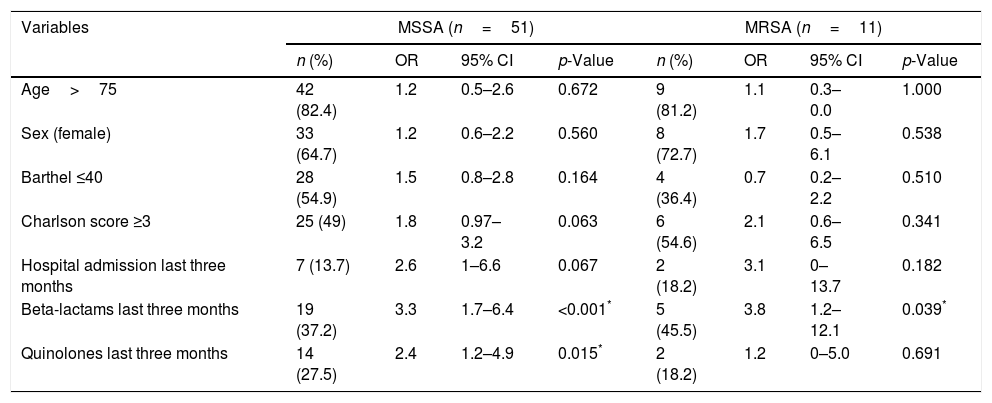Staphylococcus aureus is a health problem behind a great variety of infections. The objective of the study was to establish the prevalence and risk factors of S. aureus carriers in community nursing homes in Cadiz.
Patients and methodA cross study from September 2016 to May 2017.
PopulationAll residents institutionalized in the largest long-term care facilities centres in Cadiz. The main variable was being a S. aureus carrier (sensitive and resistant to methicillin, MSSA and MRSA). The independent variables were age, sex, comorbidity, functional status, antibiotic therapy and hospitalisation in the last three months. Bivariate analysis with logistic regression was conducted.
ResultsPrevalence of colonization: MSSA 17,4% and MRSA 3.8%. Use of beta-lactams was significantly related to a MSSA and MRSA carrier status using multivariate logistic regression OR=3.3 and OR=3.8.
ConclusionsThere is a low prevalence of S. aureus carriers in the study population. Use of beta-lactams before the study was significantly associated with being a carrier colonised by MSSA and MRSA. Primary care prescriptions are a key in controlling pathogenic multiresistant strains.
Staphylococcus aureus es un problema para la salud causante de gran variedad de infecciones. El objetivo del estudio fue conocer la prevalencia y factores asociados a personas portadoras de S. aureus institucionalizadas en Cádiz.
Pacientes y métodoEstudio transversal entre septiembre de 2016 y mayo de 2017.
PoblaciónResidentes institucionalizados en los centros sociosanitarios con mayor número de plazas de Cádiz (N=359). La variable respuesta fue ser portador de S. aureus (sensible y resistente a meticilina, SASM y SARM respectivamente). Las variables independientes fueron: edad, sexo, comorbilidad, estado funcional, antibioterapia e ingreso hospitalario en los últimos tres meses. Se realizó análisis bivariado y con regresión logística.
ResultadosPrevalencia de colonización: SASM 17,4% y SARM 3,8%. Haber recibido betalactámicos se relacionó significativamente con ser portador de SASM y SARM mediante regresión logística multivariante con una OR=3,3 y OR=3,8 respectivamente.
ConclusionesExiste baja prevalencia de portadores de S. aureus en la población estudiada. Recibir previamente betalactámicos se asoció significativamente con estar colonizado por SASM y SARM. Las prescripciones desde atención primaria son esenciales para el control de cepas patógenas multirresistentes.









